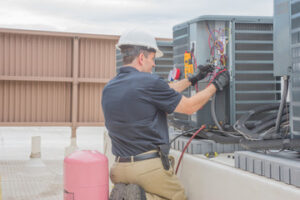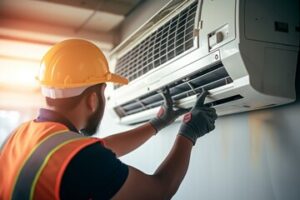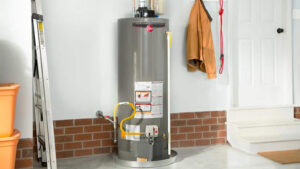A full roof replacement will cost more than repairs but will often be a more cost-effective long term solution. Repairs only cover damaged areas whereas a re-do will eliminate all existing leaks and other structural issues.

A new roof can help to increase the value of your home. In addition, a replacement can save you money on energy costs. Visit Website for more information.
When you invest in a roof replacement project, there are certain roofing materials needed to do the job properly. Your contractor will help you select a material that fits the style of your home and works well in your region’s climate.
Some options are available only in specific regions due to their fire resistance or other properties. For example, clay or ceramic tile is common in some areas but metal alternatives are growing in popularity because they’re more durable and reduce the weight on the roof. Wood shake shingles are a popular choice for homes with steeper roof pitches but are unsuitable for flat or low-sloped roofs. Asphalt composition shingles are an affordable option that’s good for most roofs. They’re also durable and available in a variety of colors.
Other roof-related materials you may need include:
* Roof decking or sheathing. This is the foundation of the roof and typically made from plywood or oriented strand board (OSB). It’s important to ensure the sheathing is in good condition before installing a new roof. * Roof sheathing boards: These are 1 by 6 inch thick sheets that create a solid surface for the shingles to adhere to. * Roofing paper: This layer is installed between the roof sheathing and shingles to add an extra layer of protection against moisture infiltration.
* Leak barrier: This self-adhesive membrane is used in vulnerable areas such as valleys, eaves, and around protrusions to prevent water penetration. * Flashing: These metal pieces seal the transition between roof surfaces and the walls of the house to prevent water intrusion.
Adding a new roof is a great way to enhance your home’s curb appeal and improve its energy efficiency. Modern roofing materials are more efficient at insulating homes, which cuts down on heating and cooling costs. Replacing an old, problematic roof can also increase the resale value of your home. Many buyers are put off by a problem-prone property, so a new roof can attract a wider pool of potential buyers. It also comes with a manufacturer warranty, which helps protect your investment.
Installation
The roof is one of the most important parts of a home, protecting it during storms and keeping the house at a comfortable temperature year-round. Over time, however, even the best roofing materials will wear out and need to be replaced. A professional roofing contractor can help you select the right type of roof and materials for your home, providing a durable, attractive new roof that will stand up to all types of weather conditions.
The first step of a roof replacement is to remove the old material. If your roof is made from asphalt shingles, the contractors will use a shingle removal tool to pull each shingle off the roof. This creates a clean base for the installation of the new roof. Other roofing materials require different removal processes and techniques. In addition to tearing off the existing roof, the team will also install new sheathing to serve as a base for the shingles and any other roofing materials.
It is a good idea to rent a dumpster to simplify the cleanup process as the contractors remove your old roof. It is also helpful to relocate any outdoor furniture, grills or pottery plants that might get damaged by the construction work. Tarps can be used to cover plants and other items that might get wet. Before the roofing crew starts, they will make sure that all necessary permits have been acquired. Many communities have specific homeowner association or architectural review board regulations that dictate which types of roofing materials can be installed on a particular home.
After the sheathing and underlayment are in place, the roofing contractor will begin to install your shingles. Asphalt shingles are the most common roofing material and offer a range of color options. They are inexpensive per square foot and are easily installed on most homes. Other types of roofing materials include metal roofs, slate roofs and wood shakes. These roofs are more expensive than shingles but they have longer lifespans and can give your home a unique appearance.
Once the roofing is finished, your contractor will perform a quality check and inspect it for any issues. This will include checking for leaks around chimneys, skylights and other points that might be vulnerable to leakage. In addition, your contractor will compare the work to local codes to ensure that it complies with all regulations.
Warranty
Roofing manufacturers typically offer a warranty to protect their products and materials against defects or failure. The terms of a manufacturer warranty may vary, but in general, they cover repairs or replacements for a specific period of time after purchase. These warranties are generally available through your roofer, or you can find them online. Most of these warranties have a life span that depends on the type of roofing materials used. For example, architectural shingles will usually be guaranteed for a longer period of time than three-tab shingles.
In addition to a manufacturer warranty, most roofing contractors also offer their own workmanship warranties. These warranty plans promise to cover repair or replacement work on your new roof in the event that there are problems caused by installer error. Typically, these plans require that you stick with the contractor who originally installed your roof to avoid voiding the original material warranty.
It’s important to understand what each type of warranty covers and how the warranty process works, so you can make an informed decision about which kind of coverage is right for your home. Some homeowner insurance policies make provisions for roofing leaks, and you can also get add-on home warranties that provide additional coverage.
If you decide to pursue a manufacturer warranty for your new roof, it’s vital to read the terms and conditions carefully. These documents outline what is and isn’t covered, and the specific circumstances that can cause a warranty to be voided. You should also ensure that your roofing contractor is certified through the shingle manufacturer to offer this type of warranty. This certification is necessary to protect your investment and ensure that any issues you experience will be addressed quickly and effectively.
It’s also important to keep in mind that most installation and contractor warranties are voided if you hire another roofing company to perform work on your home after the initial construction is complete. This is an important safeguard to prevent shoddy craftsmanship and poor workmanship, which can lead to expensive repairs down the road. It’s also a good idea to have regular inspections conducted by your roofing contractor, so they can catch small problems and fix them before they turn into bigger (and more costly) problems.
Maintenance
The roof is your home’s first line of defense against the elements. It protects your family from obvious dangers like weather events and falling tree branches, but it also shields them from less-obvious problems like energy waste and mold that can develop in a home without proper insulation and regular inspections of the entire roofing system. When a small problem goes unaddressed, it can quickly escalate into a larger, more expensive repair bill.
Keeping up with routine maintenance can help you extend the life of your roof. It includes visual inspections of the interior and exterior of your home, cleaning gutters, and removing debris from the roof. It also involves addressing minor issues that could otherwise turn into major problems, such as leaking shingles and flashing or broken window screens and soffits. Getting these minor repairs done right away can prevent expensive repairs or even a roof replacement in the future.
A complete roof replacement requires tearing off the existing shingles, felt paper or moisture barrier and replacing them with new ones. It may also involve repairing any deck damage revealed during the tear-off process. The new materials can include metal, slate, tile or wood shakes. They can offer a more aesthetically pleasing look to your home and can add value.
When it’s time for a replacement, the crew members come to your house bright and early with their trucks and equipment. They start by putting down large tarps to catch the nails and other debris that will fall off the old roof as it’s being removed. Then, they remove the rubber or lead boots around sanitary stacks and vent pipes. They also lift off the vents and ridge cap, which is installed with shingles that go in opposite directions on the top of your roof, so that water and snow flow down either side instead of seeping through where the two peaks meet.
The team can then clean and dispose of all debris from the drains, gutters and roof surfaces. Then they can re-flash splits in the field of the roof and or wall flashing, re-flash openings in penetration base flashing and replace or re-secure loose gutters and leaders. They can also re-caulk any exposed seams and joints in the existing roof surface.








